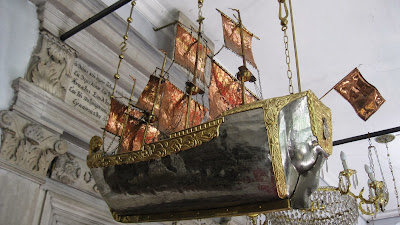Istanbul is well-known for its many beautiful mosques as well as architectural marvels from the Ottoman Empire. Under their reign, peoples from many different ethnicities and religions flourished in Istanbul. Pockets of this diverse past remain in the richly decorated churches and other religious buildings still in use today.
There are hundreds of Armenian Churches tucked away in corners of Istanbul. As the Armenian population of Istanbul has become smaller, the number of Armenian churches in use has shrunk. One still in operation is the Surp Garabed Armenian Church (Church of St John the Baptist) that I stumbled across on my way to
Çinli Camii in the Murat Reis neighbourhood of Üsküdar. Although the construction date of the church is not known, it is one of the
oldest Armenian churches in Istanbul, and has existed
at least since the year 1555. The church was originally erected as a small, wooden temple at the firman or royal decree of the sultan. It was to be used by Armenian workers, most of whom had migrated from Muş or Van to work on the
construction of many public buildings, including the Mihrimah Sultan Mosque, also in
Üsküdar. The church has been rebuilt several times
following fires, and the current church was built in stone following the
great Yenimahalle Fire in 1888, and is still open for church services today.
 |
| Courtyard of the Üsküdar Surp Garabed Armenian Church |
 |
| Interior of the Üsküdar Surp Garabed Armenian Church |
The Greek Orthodox Patriarchate has been on
the same site since about 1601, although the present Church of St George
only dates from 1720. Like all churches built in Istanbul after the conquest of 1453, it is
small in size as Christians were forbidden to build churches with domes or
masonry roofs. Although its present congregation numbers only a few thousand,
it is still the centre of the Orthodox Church. In its heyday the Ecumenical Patriarch
of Constantinople dominated the religious affairs of the entire Eastern
Christian world.
 |
| The main altar |
 |
| The Patriarchal Throne thought to date from the late Byzantine period. |
|
|
 |
| A mosaic in the portico |
 |
| Coffins of the martyrs including the bodies of St Omonia, St Theophano and St Euphemia of Chalcedon (present day Kadiköy |
Known in
Greek as the Megali Scholio, or the Great
School, the Özel Fener Rum Lisesi (Fener Greek
Orthodox College)
was founded before the conquest of Istanbul.
It remained the principal Greek institution of secular education throughout the
course of Ottoman history. The present building was designed by the Ottoman
Greek architect Konstantinos Dimadis in 1881 and continues to educate pupils
today, providing a full Turkish curriculum as well as a thorough grounding in
Greek language, literature and religion.

In Byzantine times, there were at least
three monasteries on Heybeliada (Saddle Bag island), then known as Halki. Today,
only the Hagia Triada (Holy Trinity) monastery remains, standing on the crest
of Ümit hill. With a long history that predates the conquest, the building
housed the main Greek Orthodox theological seminary in Turkey until it
was closed in 1971. To this day a former teacher of mathematics visits the
school every Wednesday to take tea and reminisce about his former colleagues and pupils.


Meryem Ana (Church of the Virgin Mary) in Karaköy,
was built in 1583 by Tryfon Karabeinikov. It is more popularly known as Santa Maria
de Kaffa (Panagia Kaphatiani) because it was founded by the Greek community of
Kaffa (Crimean Greeks). It is now the headquarters of the Patriarchate of the
Turkish Orthodox Church whose origins can be traced back to the Greco-Turkish War. In 1922 a pro-Turkish Orthodox group was set up consisting of
the Turkish-speaking, Orthodox Christian Karamanlides
population of Anatolia
who wished to remain both Orthodox and Turkish. The group has had a
turbulent history and religious services ceased to be held in the church in 2008.
And of course, everybody's favourite, the Haghia Sophia in Sultanahmet.
 |
| Photographed November 2000 |














No comments:
Post a Comment